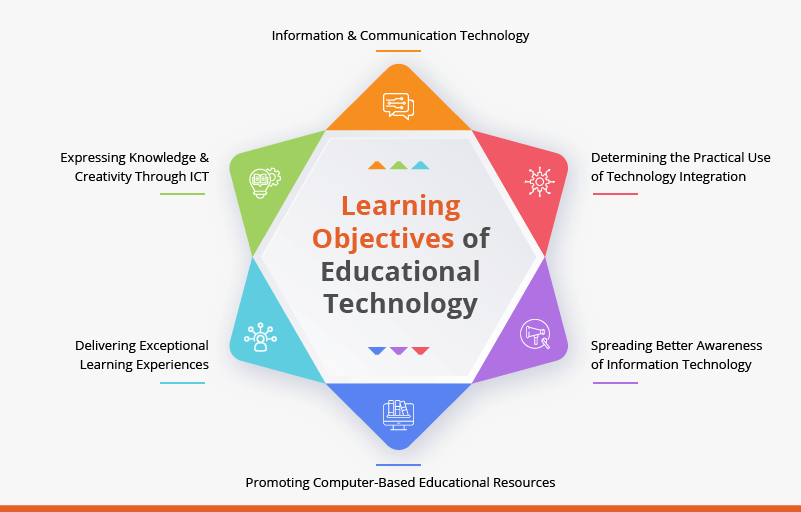What are the Objectives and Benefits of Educational Technology

Technology, specifically digital technology, is omnipresent in every aspect of our lives. From healthcare to entertainment – every sector is leveraging technology to do more for its audiences. Education is not an exception. Using technology to improve the standard of education is no longer limited to audio-visual aids and laptops. Instead, educational technology has evolved to empower educators and learners to analyse, interpret, and personalise learning experiences.
Importance of Objectives of Educational Technology
Educational technology, or EdTech, is a growing technology sphere that allows learners to learn better using interactive hardware or software. It involves finding intelligent solutions to create immersive learning experiences for everyone. Learners benefit through memorable learning experiences that stay with them for life, and teachers benefit by achieving their educational goals in a shorter time. Suppose you are an educator who is curious about the objectives of educational technology and wants to know more before implementing EdTech in your institution. In that case, you are in the right place. This article will elaborate on educational technology’s objectives, functions, and scope. Read on to know more.
Learning Objectives of Educational Technology

- Information & Communication Technology: Information and communication technology or ICT is significant in the real world. Students who begin working with ICT from a young age quickly learn to use it for higher studies, projects, and jobs. An essential objective of EdTech is to provide education in information and communication technology to all students.
- Expressing Knowledge & Creativity Through ICT: In modern education, learners must present their subject matter knowledge and proficiency through holistic assessments such as presentations, debates, and projects. It helps them learn how to use ICT to express their knowledge and creativity in a way that is understandable to everyone. It is an important life skill that educational technology teaches modern learners.
- Delivering Exceptional Learning Experiences: Modern learners are surrounded by digital technology in their personal lives. If education is limited to non-technical means, it may never succeed in engaging learners in the digital age. Therefore, the next objective of educational technology is to deliver immersive and memorable learning experiences using modern instructional technology.
- Promoting Computer-Based Educational Resources: A few decades ago, schools only had libraries and books to offer as educational resources to learners. But now, with information and communication technology – the world is their oyster. Educational technology enables institutions to provide limitless computer-based educational resources to their learners through the Internet.
- Spreading Better Awareness of Information Technology: Information technology is one of the world’s most significant spheres of knowledge. In the coming years, all industries will be working with IT tools and solutions – and those unaware of information technology may not be employable. Therefore, educational technology strives to make all learners familiar and comfortable with information technology from a young age.
- Determining the Practical Use of Technology Integration: Implementing educational technology is the first step to determining the practical use of technology integration. Educators are encouraged to experiment with different educational aids and analyse the results over time. It can help school leaders and administrators determine the best use of educational technology in their institution.
Functions of Educational Technology at the Macro Level
- Identifying Needs & Aspirations: An essential function of educational technology is identifying learners’ diverse educational needs and fulfilling them to achieve their academic aspirations. Although every learner has unique educational needs, educational technology solutions can help highlight the gaps at a macro level. Trends and insights from thousands of schools can show us the areas that need the most help.
- Creating a Deeper Understanding of the Education Board: At the ground level, teachers often struggle to understand the policies and processes of the governing education board. Educational technology can open new avenues of communication to help all members of the pedagogical community develop a deeper understanding of the education board processes and its objectives.
- Improving the Curriculum: Educational technology can not only help educators review the curriculum and improve it – but it can also help make the curriculum more relevant to modern learners. Technology allows the creation of better learning content aligned with science, design, and human values.
- Assets & Instruments: EdTech is instrumental in creating proper assets and instruments that support a learner’s educational pursuits. When a learner’s needs are well-supported, they are motivated to learn and spend more time in the learning process. Technological support can help students learn at their own pace.
- New Teaching-Learning Models: Technology can help teachers and school leaders create new pedagogical techniques, instructional approaches, and methods that suit modern learners.
- Environmental Restrictions: Educational technology can help our institutions recognise and discover remedies to prevent significant environmental restrictions. If our schools are sustainable, they will encourage future generations to adopt a more sustainable lifestyle.
- Elevate the Entire Educational Ecosystem: Heads of institutions can use educational technology to handle the governance of the entire educational academy, from preparing the lesson plans to efficient implementation, administration, and evaluation of the education ecosystem.
Functions of Educational Technology at a Micro Level
- Understanding Unique Educational Requirements: Students are unique in their strengths, weaknesses, and learning needs. Educational technology helps customise the learning environment, instruction, and pedagogy based on the learner’s characteristics and preferences.
- Defining Classroom Objectives: A significant objective of educational technology is to determine and redefine the specific classroom objectives in behavioural terms. Thus, making them simpler to understand and follow for everyone.
- Examine the Scope of Learning: Educational technology can help examine the scope of the curriculum to ensure that it is challenging for students and define them in the proper sequence.
- Identifying the Relationships Among Different Elements of the Learning Ecosystem: Educational technologies aim to determine the nature of the interaction among the different sub-systems in an educational institution, like students, teachers, teaching-learning materials, the content of the curriculum, and pedagogical approach.
- Leveraging Technology to Attain Classroom Objectives: Educational technology aids teaching strategies and available human resources and materials to help accomplish classroom objectives.
- Identifying the Effectiveness of Classroom Teaching: Continuously evaluating changes in students’ behaviour and performance can help determine the effectiveness of classroom teaching using educational technology.
- Feedback: Technology allows teachers and students to give and receive honest, anonymous feedback in real-time.
Scope of Educational Technology
With NEP 2020 promoting the integration of AI, digital tools, and personalized learning, the scope of educational technology has expanded to create dynamic, student-centric learning environments accessible anytime, anywhere. It can improve the efficiency and effectiveness of processes and allow educators to create new methodologies to enhance learning experiences. Educational technology can also help analyse a student’s personality and preferences to help educators develop their personality as they learn. Below is a list of the broad scope of education technology:
- It makes teaching and learning more efficient, effective, and process-oriented.
- Mechanical and electronic gadgets can easily be used as teaching or learning aids.
- Digital technology in education offers modern teaching aids and programmed instructional material to create immersive learning experiences.
- Traditional mediums like television, radio, tape recorder, VCR, and computers can be used for correspondence and distance learning programs.
- The Internet allows learners to access educational content anytime and from anywhere.
- Real-time feedback helps teachers improve their methods, especially the teachers-in-training in academic institutions.
- Long-standing educational administrative obstacles can be overcome using technology-driven innovative analytical tools.
- Educational technology can help develop and revolutionise the teaching structure and the learning ecosystem.
Extramarks – Your Educational Technology Partner
Extramarks is a new-age educational technology company that aims to empower educators to create better learning experiences. We create innovative digital learning solutions that cover all subjects and follow a curriculum-based approach—partner with us to deliver technology-powered learning experiences and teaching aids to your students today. Our flagship solutions include:
- Smart Class Solutions: Creating technology that transforms classrooms into more engaging and learner-centric environments.
- School Integrated Program: Enabling students to prepare for NEET/IIT-JEE tests through live online classes taken by Extramarks faculties.
- Virtual School Environment: Bringing the entire school online enables teachers to take live classes and assign homework, worksheets, and weekly tests.
- Extramarks Assessment Platform: Automating assessment activities through a scientifically designed and customised assessment platform.

Make EdTech more impactful with interactive classroom activities tailored for smart learning. Get your free Smart Classroom Toolkit now!
Last Updated on April 8, 2025
Reviewed by

Priya Kapoor | AVP - Academics
Priya Kapoor is an accomplished education professional with over 18 years of experience across diverse fields, including eLearning, digital and print publishing, instructional design, and content strategy. As the AVP – Academics at Extramarks, she leads academic teams in creating tailored educational solutions, ensuring alignment with varied curricula across national and international platforms...read more.











